We may be compensated if you purchase through links on our website. Our team is committed to delivering honest, objective, and independent reviews on home products and services.
Project details
Skill
Cost
Estimated Time
You can add a slice of the beach to your backyard by building your very own do-it-yourself sandbox for your kids. This project requires moderate skill and some heavy lifting, but the cuts are straightforward, and the assembly is manageable. Read how to complete this project in a single weekend in the step-by-step guide below so that you and your family can enjoy your outdoor space in a brand new way.
DIY Sandbox Overview
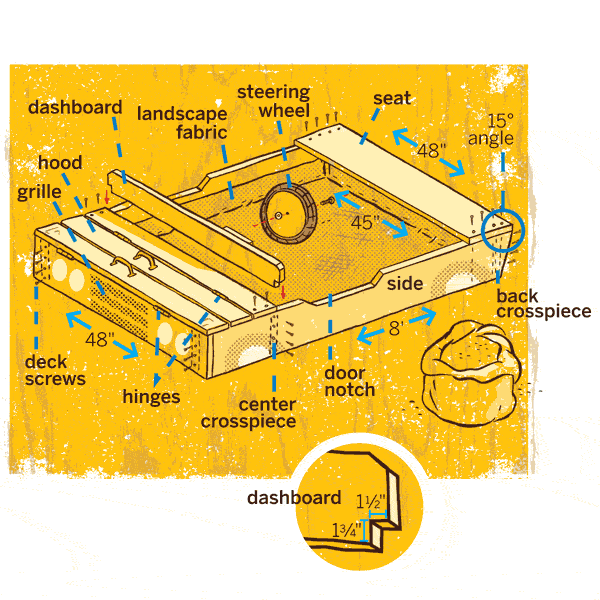
The sandbox car in the video above is primarily made of 2×12 beams, which form the four sides and the seat. The dashboard and hood, which opens to reveal storage, are made of 1/2×6 decking. Landscape fabric on the bottom prevents weed growth, and the “play sand” that fills the sandbox is free of debris.
Assemble the sandbox in a workspace such as your garage before moving it to a level spot outside. Support the beams on blocks or sawhorses and drill pilot holes before screwing the project’s parts together.
Step 1: Lay Out and Cut the Sandbox Parts
Follow the steps below to lay out and cut the parts:

- Cut one 2×12 beam into two 48-inch pieces for the grille and seat.
- Cut another 2×12 beam into two 45-inch pieces for the back and center crosspieces.
- Cut the decking into four 48-inch pieces for the hood and dashboard.
- Shape the tail fins by cutting one end of each side piece at 15-degree angles.
- Cut out 1 5/8-by-17 1/2-inch notches for the doors on each side.
- Cut four 11 1/4-inch corner supports and one 6-inch block for the steering wheel mount from the two-by-four.
Step 2: Line Up the Parts of the Sandbox
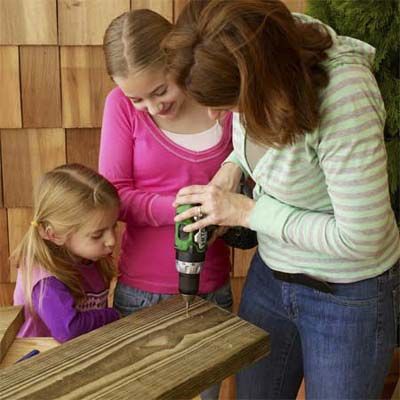
Follow the steps below to line up the parts. Make sure you align your pieces properly to keep your structure sturdy.
- Drill four evenly spaced pilot holes into the back crosspiece so that they’re 3/4 inch from the ends.
- Drill four evenly spaced pilot holes into the front grille piece so that they’re 2 1/4 inches from the ends.
- Lay down each side piece so that the insides are facing up, and attach the corner supports. Make sure the front corner supports are flush with the front edge of the side. Make sure the back corner support is inset 1 1/2 inches from the bottom edge of the tail fins.
- Measure 14 1/4 inches from the front end along each side and drill four pilot holes down the face for the center crosspiece.
Use a square to keep your measurements and drill holes accurate. This will make assembly much easier.
Step 3: Assemble the Sandbox
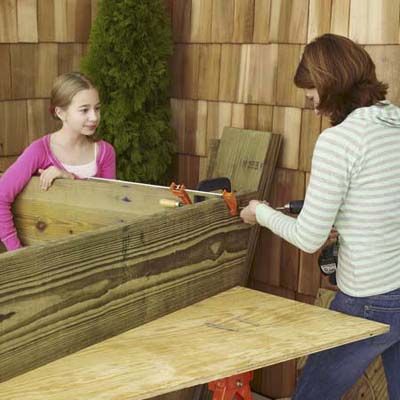
Follow the steps below to assemble the sandbox:
- Stand the sides up and align the back crosspiece between them. Screw through the pilot holes into the edges of the back corner supports.
- Line up the center crosspiece with its pilot holes and fasten it into place.
- Place the grille across the front of the box and screw it to the edges of the corner supports.
- Screw the seat to the sides’ top edges.
Be careful not to overtighten when you’re screwing pieces together, as this can split the wood. Use a level to keep your sandbox square and even. A structure that you assemble correctly will remain stable and durable.
Step 4: Add the Dashboard to the Sandbox
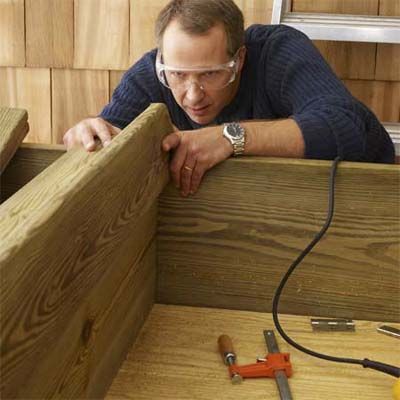
Follow the steps below to add the dashboard, which contributes to the structure of your piece.
- Align the back edge of your first hood board with the back edge of the crosspiece. Screw the hood board onto the sides.
- Stand the notched dashboard up and line it up with the edge of the first hood board.
- Screw the dashboard into the back of the crosspiece.
Ask your children to help hold pieces in place while you secure them. This can teach them valuable DIY skills.
Step 5: Put the Hood on the Sandbox
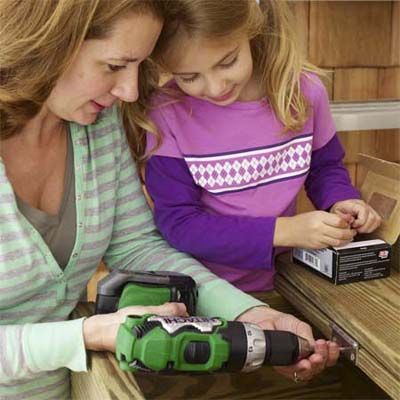
Follow the steps below to put on the hood, which adds a fun, interactive element to your design:
- Lay two hinges on the front edge of the first hood piece, about 8 inches in from the ends. Position the hinges so that one leaf is on the decking and the other hangs over the front.
- Lay another piece of decking on top to hold the hinges in place.
- Screw the front leaves of the hinges to the edge of the first hood piece.
- Remove the top piece and stand up the hinges. Replace the top piece, and align it with the first hood piece. Screw the other leaves onto its edge.
- Attach the second set of hinges to the grille. Allow the leaves to hang over the front.
- Flip the unattached leaves up and screw them to the back face of the last hood piece.
This design allows the hood doors to open in opposite directions. Children will enjoy the interactive elements.
Step 6: Cut Out the Steering Wheel for the Sandbox
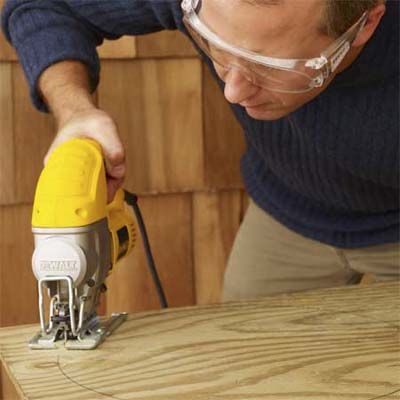
Follow the steps below to cut out the steering wheel and add another interactive element to your construction:
- Use the plastic or cardboard form from the wheel cover as a template for the steering wheel.
- Place it on a piece of 1/2-inch plywood and trace around it.
- Clamp the plywood securely to the worktable.
- Use a jigsaw to carefully cut out the steering wheel. You may need to stop midway through the cut to reposition the plywood.
Step 7: Paint the Sandbox
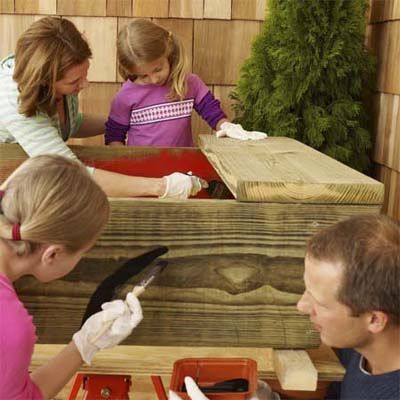
Follow the steps below to paint your construction and bring your sandbox car to life:
- Stain the inside and outside of the sandbox red. Stain the plywood steering wheel and the 6-inch block too.
- Use a compass to draw wheels at the back end of the sides, including the hubcaps that are inside them.
- Draw headlights and the grille pattern on the front of the sandbox.
- Paint the wheels and the grille pattern black. Paint the headlights and hubcaps silver.
Use non-toxic, child-safe paints and stains for this project. Allow the paints or stains to dry between coats. Use bright colors to make the sandbox a favorite play spot.
Step 8: Place the Sandbox Outside
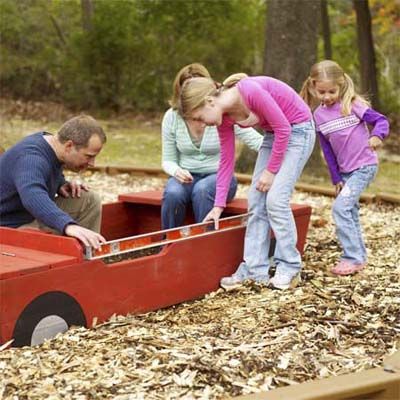
Follow the steps below to properly place the sandbox outside:
- Dig out an area until it is level, then rake it smooth.
- Place the sandbox on the ground you cleared.
- Use a 4-foot level to make sure the sandbox is level in both directions. If it isn’t, rake or dig the ground underneath until it is.
Consider placing the sandbox in a partially shaded area to protect children from excessive sun exposure.
Step 9: Make the Sandbox Lining
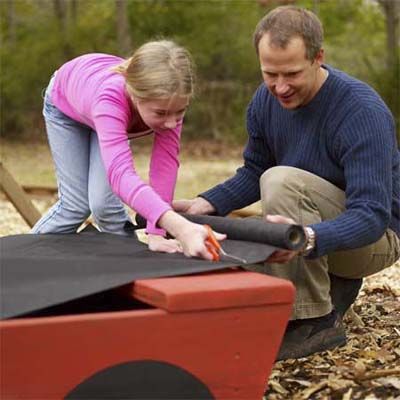
Follow the steps below to make the lining for the sandbox, which will keep it clean and free of weeds:
- Unroll a piece of landscape fabric and cut it so that it’s long enough to fit along the bottom and up the sides of the sandbox. You’ll need two pieces to cover the width of the box.
- Line the bottom of the box with the fabric.
- Use a staple gun to attach the fabric a few inches up the sides.
- Tuck the fabric into the corners so that it won’t rip when you add the sand.
Step 10: Add Sand to the Sandbox

Follow the steps below to add the sand to your sandbox which will help to keep your children safe during play:
- Fill the box with specialty play sand that’s screened for children’s use.
- Use a metal rake to smooth the sand until it’s level.
Cover the sandbox when children aren’t using it to keep out debris and animals. You can make a custom-fit cover from water-resistant fabric or a tarp.
Step 11: Affix the Steering Wheel to the Sandbox
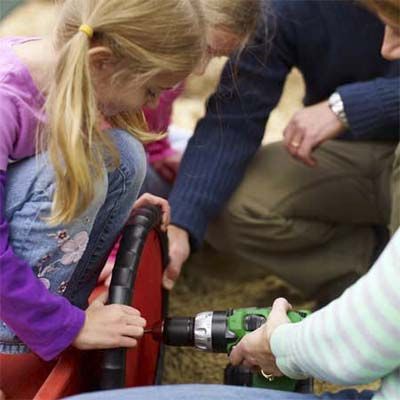
Follow the steps below to add a fun steering wheel to your sandbox car:
- Fit the wheel cover around the plywood steering wheel.
- Screw the 6-inch block to the dashboard where you plan to put the steering wheel.
- Screw the wheel to the block through the center. Use a washer between the two so that the wheel can spin.
Step 12: Mount the Sandbox Hood Ornament
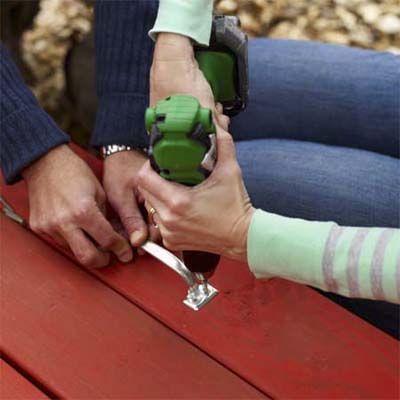
Attach the two handles to the hinged decking pieces so that they face each other and collectively resemble a hood ornament. Choose handles that are smooth and child-safe to prevent any injuries during play.
Step 13: Enjoy Your Completed Sandbox!
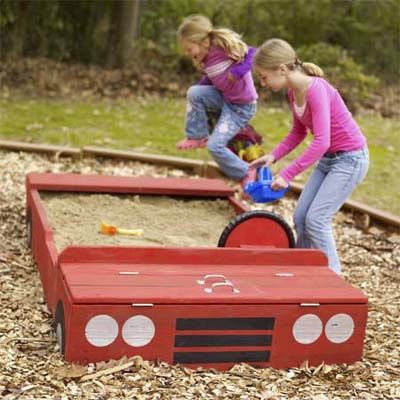
Your DIY sandbox car is now ready for action. Remember to regularly check the sandbox for any wear and tear, and always supervise children during play.
Maintaining Your Sandbox
Follow the steps below to keep your sandbox safe and enjoyable:
- Regularly rake the sand to prevent compaction, and remove any debris.
- Replace the sand every year to keep the sandbox clean.
- Check for any loose screws or protruding edges and repair them immediately.
Tools:
 Tape measure
Tape measure Layout square
Layout square Jigsaw
Jigsaw bar clamps – 4-ft.
bar clamps – 4-ft. drill bit – 1/8-inch
drill bit – 1/8-inch Drill/driver
Drill/driver Safety glasses
Safety glasses Paint brushes
Paint brushes Shovel
Shovel Metal rake
Metal rake level – 4-foot
level – 4-foot Utility scissors
Utility scissors Staple gun
Staple gun Compass
Compass













